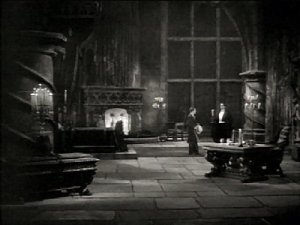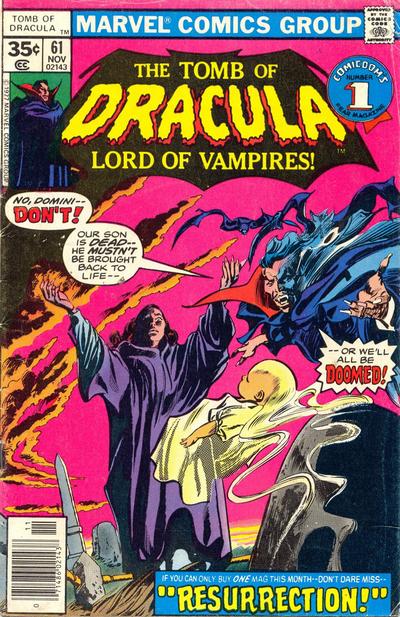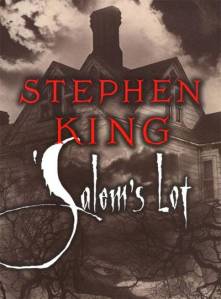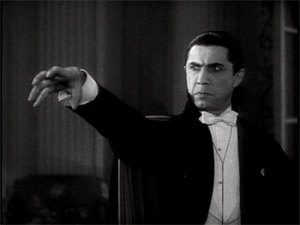So, onto the second Dracula film….the famous Universal production of 1931. There was a Hungarian film that predates it, but this no longer exists and was not a true adaptation of the novel, so we’ll skirt over that one.
Firstly though, let’s continue to talk vampires.
I got into mythology and folklore in my teens and the vampire fascinated me. A potent time to gain an interest as one’s sexuality begins to awaken and I imagine for women especially the idea of blood gains new significance. I saw Hammer’s series some time in the ’80s on late night re-runs, with Christopher Lee. They were extremely gaudy and colourful to my teen eyes, and not particularly scary; although I did find them mildly erotic and wonderfully stylish. Not sure which one would have been my first Hammer. I’m thinking it was Dracula- Prince of Darkness, but the memory cheats a little. I certainly didn’t see the 1958 Hammer version of the book until a couple of years ago, although I was familiar with the showdown scene between Cushing and Lee involving the curtain. Not sure where I would have seen that, but I only saw the full film recently, and intend to watch it again for this thread. I was a bit underwhelmed by it, to be honest, due to the high expectation I had- but more of that later.
Elsewhere I’ve seen other vampire films. I do like the other Hammers, and Countess Dracula, with the late Ingrid Pitt, is a favourite. I also loved Vampyros Lesbos, which, quite frankly, was a bit of European vampire soft porn (let’s not pretend it’s anything else!) Underworld and Blade entertained to a degree, but I prefer things more traditionally gothic. Blade, incidentally, was a spin-off from Marvel comics’ much lauded ‘70s title Tomb of Dracula, in which The Count is resurrected in the present day and Stoker’s book is treated as if it was a document of real events. The modern ascendants of Van Helsing, Harker, et al, team together with some new characters to over-throw the Vampire Lord’s evil schemes. Plus Dracula gets to fight Spider-Man and The Silver Surfer, which is either especially cool or a travesty of classic literature, depending on how you view things. Overall, Tomb of Dracula introduced the character to a whole new generation that was too young for Hammer (who’s style the Marvel comic emulated). Buffy was also a good series in many ways, but I feel it failed miserably as a vampire series. By turning the vampire into part of a teen high school drama, the series forgot to treat the dark fable with any reverence in my view. The vampire should be erotic and scary, and Buffy and Angel were neither.
My experience of vampire literature has been surprisingly limited actually. I haven’t touched Anne Rice’s novels yet, for example. But I have read Stoker’s great novel, and also class Stephen King’s second novel ‘Salem’s lot as a brilliant book. As King says, all these years later, it’s still one of his good ones; one of the scary ones…
So the vampire fascinates me. Occasionally (very occasionally, mind) I’ll consider if such a horror could exist, and what an eternity of hunger and flawless alabaster flash would be like…but some things are better off left to the world of fiction. God may have put eternity into the heart of every man, but what happens when your heart stops beating? It’s a frightening idea. No matter what worlds and other possible lives may await us, an eternity on Earth in constant blood lust, never able to see a sunrise again, is surely a tragic kind of hell.
So let’s dim the lights and slide the DVD in your player, or turn the page of your book. Somewhere in your psyche is a dark part that will believe in the fiction, and we’ll be scared together.
Was that your door creaking, or mine? Or was it….something else…..
Dracula (Todd Browning, 1931)
 Todd Browning’s 1931 version of Dracula is a classic for many reasons, but especially for the way it came to define the character of the Count in the popular imagination. Such was the visual impact of Universal studio’s horror output in the ‘30s and ‘40s. As with Boris Karloff as the monster in Universal’s version of Frankenstein, released the same year, Lugosi’s interpretation of Dracula is considered by many to be definitive. They are not as Shelley or Stoker originally envisioned their characters, but they have become what most people imagine them to look like. Lugosi’s performance as Dracula has influenced most of the performances made later, by other actors. Add to that the rather creepy atmosphere pervading much of the film, and you have a horror picture that has endured. To a modern audience it isn’t all that scary, but it leaves much to the imagination, which is no bad thing.
Todd Browning’s 1931 version of Dracula is a classic for many reasons, but especially for the way it came to define the character of the Count in the popular imagination. Such was the visual impact of Universal studio’s horror output in the ‘30s and ‘40s. As with Boris Karloff as the monster in Universal’s version of Frankenstein, released the same year, Lugosi’s interpretation of Dracula is considered by many to be definitive. They are not as Shelley or Stoker originally envisioned their characters, but they have become what most people imagine them to look like. Lugosi’s performance as Dracula has influenced most of the performances made later, by other actors. Add to that the rather creepy atmosphere pervading much of the film, and you have a horror picture that has endured. To a modern audience it isn’t all that scary, but it leaves much to the imagination, which is no bad thing.
The long periods of silence in the film also help give a far more eerie atmosphere in my opinion. There is actually a version with a different soundtrack, and a score created in 1999 which apparently doesn’t do justice to the film (matter of opinion again, of course). The production design (especially Castle Dracula) is generally sumptuous. The sets look a little stagy (like the acting) but this is to be expected for the time (and particularly here, in an adaptation of a stage play version). Sadly, I have to say once we pass the very impressive and suitably cinematic opening in Transylvania and the castle, we then return to the London home of Mina (Helen Chandler) and Jonathan Harker (David Manners), and everything becomes far less visually exciting and (again) rather too stagy.
 Also on the downside, I do find it too slow in places and the theatrical style presentation I mentioned can undo much of the possible conviction of the performances. Many of the performances here are far too mannered and as wooden as the dressing, although there are exceptions. Universal horror regular Edward Van Sloan is very engaging as Van Helsing, and Dwight Frye almost upstages Lugosi as a very loopy Renfield (given a larger role here than in more faithful versions of the novel). Chandler and Manners fill their roles well enough, but are often too affected for my taste.
Also on the downside, I do find it too slow in places and the theatrical style presentation I mentioned can undo much of the possible conviction of the performances. Many of the performances here are far too mannered and as wooden as the dressing, although there are exceptions. Universal horror regular Edward Van Sloan is very engaging as Van Helsing, and Dwight Frye almost upstages Lugosi as a very loopy Renfield (given a larger role here than in more faithful versions of the novel). Chandler and Manners fill their roles well enough, but are often too affected for my taste.
 Bela Lugosi’s performance, however, is the key to the film’s success. Easy now to mock his theatrical gestures and accent, but as far as this is from the Bram Stoker original, this is a captivating central performance from a true Eastern European. Lugosi, never topped his success here, and only played Dracula twice on screen, but his interpretation is the version of Dracula that most readily springs to mind, accent, gestures, cape and all. His take on Dracula is no where near as horrific as Max Shreck in “Nosferatu” (and the film he’s in is no where near as impressive) but it’s a very captivating performance nevertheless.
Bela Lugosi’s performance, however, is the key to the film’s success. Easy now to mock his theatrical gestures and accent, but as far as this is from the Bram Stoker original, this is a captivating central performance from a true Eastern European. Lugosi, never topped his success here, and only played Dracula twice on screen, but his interpretation is the version of Dracula that most readily springs to mind, accent, gestures, cape and all. His take on Dracula is no where near as horrific as Max Shreck in “Nosferatu” (and the film he’s in is no where near as impressive) but it’s a very captivating performance nevertheless.
 Ultimately Dracula is all too apparently a film version of a stage play, made at the beginning of the sound era. This gives the whole production many of the qualities of a stage production, thereby wasting much of the potential of the film medium. Perhaps outside of Hollywood the film would have been more experimental and subversive, perhaps with blood and death on display and less action talked about and not shown (although much of that is to do with what was then acceptable). The film also has a very abrupt ending that may leave a modern audience feeling a bit cheated. But despite its dated qualities and flawed presentation, Dracula remains an atmospheric and highly influential version of the story, and one that started the great tradition of 1930s horror film-making from Universal pictures. It’s an old classic, its silver images lulling us into a comfortable nostalgic viewing experience, while retaining some of the eerie menace the 1931 audience would have felt.
Ultimately Dracula is all too apparently a film version of a stage play, made at the beginning of the sound era. This gives the whole production many of the qualities of a stage production, thereby wasting much of the potential of the film medium. Perhaps outside of Hollywood the film would have been more experimental and subversive, perhaps with blood and death on display and less action talked about and not shown (although much of that is to do with what was then acceptable). The film also has a very abrupt ending that may leave a modern audience feeling a bit cheated. But despite its dated qualities and flawed presentation, Dracula remains an atmospheric and highly influential version of the story, and one that started the great tradition of 1930s horror film-making from Universal pictures. It’s an old classic, its silver images lulling us into a comfortable nostalgic viewing experience, while retaining some of the eerie menace the 1931 audience would have felt.





Leave a comment